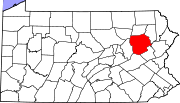Wilkes-Barre, Pennsylvania
| City of Wilkes-Barre | |
|---|---|
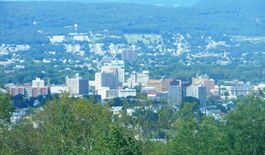 |
|
| Nickname(s): The Diamond City | |
| Motto: Pattern After Us | |
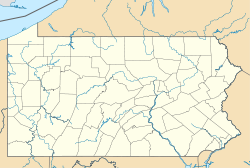 City of Wilkes-Barre
|
|
| Coordinates: | |
| Country | United States |
| State | Pennsylvania |
| County | Luzerne |
| Founded | 1769 |
| Incorporated | 1806–Borough |
| 1871–City | |
| Government | |
| - Mayor | Thomas M. Leighton (D) |
| Area | |
| - City | 7.2 sq mi (18.6 km2) |
| - Land | 6.9 sq mi (17.7 km2) |
| - Water | 0.3 sq mi (0.9 km2) |
| Elevation | 525 ft (160 m) |
| Population (2000) | |
| - City | 43,123 |
| - Density | 6,295.2/sq mi (2,430.6/km2) |
| - Metro | 624,776 |
| Time zone | EST (UTC-5) |
| - Summer (DST) | EDT (UTC-4) |
| Website | www.wilkes-barre.pa.us |
Wilkes-Barre (pronounced /ˈwɪlksbɛrə/ or /ˈwɪlksbɛri/) is a city in Northeastern Pennsylvania, United States. It is the county seat of Luzerne County and the center of the Wyoming Valley. Founded in 1769 and formally incorporated in 1806, the city has an estimated population of 43,123, according to the 2000 census. Wilkes-Barre is one of the two cities of the Scranton-Wilkes Barre, Pennsylvania Metropolitan Statistical Area which has an estimated 2007 population of 549,430.[1]
Wilkes-Barre and surrounding Wyoming Valley are framed by the Pocono Mountains to the east, the Endless Mountains to the west and the Lehigh Valley to the south. The Susquehanna River flows through the center of the valley and defines the northwestern border of the city.
History
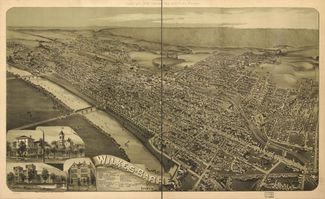
Beginnings
The Wyoming Valley was first inhabited by the Shawanese and Delaware Indian tribes in the early 1700s. By 1769, a group, led by John Durkee, became the first Europeans to reach the area. The settlement was named Wilkes-Barre after John Wilkes and Isaac Barré, two British members of Parliament who supported colonial America.
The initial settlers were aligned with Connecticut, which had a claim on the land that rivaled Pennsylvania's. Armed men loyal to Pennsylvania twice attempted to evict the residents of Wilkes-Barre in what came to be known as the Pennamite Wars. After the American Revolution, the conflict was resolved so that the settlers retained title to their lands but transferred their allegiance to Pennsylvania.
Industrial foundations: manufacturing, coal and railroads
Wilkes-Barre's population exploded due to the discovery of anthracite coal in the 1800s, which gave the city the nickname of "The Diamond City." Hundreds of thousands of immigrants flocked to the city, seeking jobs in the numerous mines and collieries that sprung up.
20th century
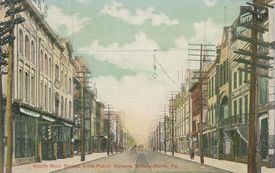
The coal industry survived several disasters, including an explosion at the Baltimore Colliery in 1919 that killed 92 miners, but it could not survive the gradual switch to other energy sources. Most coal operations left Wilkes-Barre by the end of World War II, and the 1959 Knox Mine Disaster marked the end of King Coal's heyday. The city entered into a decades-long decline, hastened by Hurricane Agnes in 1972.
Disastrous flooding
Manufacturing and retail remained Wilkes-Barre's strongest industries, but the city's economy took a major blow from Tropical Storm Agnes in 1972. The storm pushed the Susquehanna River to a height of nearly 41 feet, four feet above the city's levees, flooding downtown with nine feet of water. While no lives were lost, 25,000 homes and businesses were either damaged or destroyed, and damages were estimated to be $1 billion, with President Richard Nixon sending aid to the area.
Throughout the 1970s and 1980s, Wilkes-Barre attempted to repair the damage from Agnes by building a levee system that rises 41 feet; it has successfully battled less threatening floods of 1996, 2004, and 2006, and the Army Corps of Engineers has praised the quality of the levees.
21st century
On June 9, 2005, Mayor Thomas M. Leighton unveiled his I believe... campaign for Wilkes-Barre, which was intended to boost the city's spirits. Construction began on a planned downtown theatre complex which had a grand opening on June 30, 2006, and renovation of the landmark Hotel Sterling was being pursued by CityVest, a nonprofit developer. The expansion of Wilkes University and King's College has taken place. Also, the canopy and matching street lights in Public Square and across downtown were removed; the replacements are new green lampposts.
In 2006, the City of Wilkes-Barre celebrated its 200th anniversary. There were several events which were scheduled to commemorate this occasion over the July 4 weekend, including a free concert with the Beach Boys in the city's Kirby Park. However, due to extremely heavy rains, the Susquehanna River crested high enough that most of the city had to be evacuated on June 28, 2006, forcing the cancellation of the events. Afterwards, the city rescheduled their Bicentennial Blastoff, their Bicentennial Parade and the Bicentennial Gala to different dates throughout August. The Beach Boys graciously rescheduled their concert and played a Kirby Park concert on Labor Day Weekend, Sunday September 3, 2006, attended by Pennsylvania Governor Ed Rendell.
Government
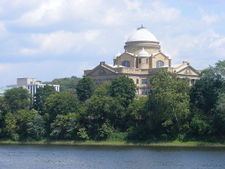
Executive
The city is headed by a mayor, elected to a four-year term. The current mayor is Tom Leighton, a Democrat who was first elected to office in 2003.
Legislative
The legislative branch of Wilkes-Barre is the City Council, comprising five members who are elected by district to four-year terms. Current members of Council are: Chairperson Tony Thomas Jr.; Vice Chairperson Kathy Kane; Bill Barrett (former Wilkes-Barre police chief); Rick Cronauer; and Michael Merritt.
Judicial
The City of Wilkes-Barre is served by two City Attorneys, Timothy Henry, Esquire and William E. Vinsko, Jr., Esquire, who advise both the Mayor and City Council.
The Luzerne County Court of Common Pleas is the trial court of general jurisdiction for Wilkes-Barre. Its probation system is divided into two divisions; one for adults, and one for juveniles.
The U.S. Bankruptcy Court for the Middle District of Pennsylvania sits at the Max Rosenn United States Courthouse in downtown Wilkes-Barre on South Main Street. The Chief Judge of the Bankruptcy Court, John J. Thomas, is son of Thomas C. Thomas, a prominent produce dealer whose terminal remains a prominent part of the Wilkes-Barre skyline.
Demographics
| Historical populations | |||
|---|---|---|---|
| Census | Pop. | %± | |
| 1810 | 1,225 |
|
|
| 1820 | 755 | −38.4% | |
| 1840 | 1,718 |
|
|
| 1850 | 2,723 | 58.5% | |
| 1860 | 4,253 | 56.2% | |
| 1870 | 10,174 | 139.2% | |
| 1880 | 23,339 | 129.4% | |
| 1890 | 37,718 | 61.6% | |
| 1900 | 51,721 | 37.1% | |
| 1910 | 67,105 | 29.7% | |
| 1920 | 73,833 | 10.0% | |
| 1930 | 86,626 | 17.3% | |
| 1940 | 86,236 | −0.5% | |
| 1950 | 76,826 | −10.9% | |
| 1960 | 63,068 | −17.9% | |
| 1970 | 58,856 | −6.7% | |
| 1980 | 51,551 | −12.4% | |
| 1990 | 47,523 | −7.8% | |
| 2000 | 43,123 | −9.3% | |
| Est. 2008 | 40,932 | −5.1% | |
As of the census[2] of 2000, there were 43,123 people, 17,961 households, and 9,878 families residing in the city. The population density was 6,296.3 people per square mile (2,430.6/km²). There were 20,294 housing units at an average density of 2,963.1/sq mi (1,143.9/km²). The racial makeup of the city was 92.30% White, 5.09% African American, 0.11% Native American, 0.79% Asian, 0.03% Pacific Islander, 0.53% from other races, and 1.15% from two or more races. Hispanic or Latino of any race were 1.58% of the population.
The average household size was 2.20, and the average family size was 2.96.
In the city the population was spread out with 19.9% under the age of 18, 12.6% from 18 to 24, 26.1% from 25 to 44, 20.8% from 45 to 64, and 20.6% who were 65 years of age or older. The median age was 39 years. For every 100 females there were 93.2 males. For every 100 females age 18 and over, there were 90.7 males.
The local accent of American English is Northeast Pennsylvania English.
Geography
Wilkes-Barre is located at .[3]
According to the United States Census Bureau, the city has a total area of 7.2 square miles (18.6 km²).6.8 square miles (17.7 km²) of it is land and 0.3 square miles (0.9 km²) of it is water. The total area is 4.60% water. While the Susquehanna River has a wide floodplain that has necessitated the construction of floodwalls to protect a large percentage of the city, the areas away from the river increase in elevation approaching Wilkes-Barre Mountain. The approximate elevation for the majority of the city is about 525 feet above sea level.
Adjacent municipalities
- Wilkes-Barre Township(southeast)
- Plains Township (east and northeast)
- Kingston (north)
- Edwardsville (northwest)
- Larksville (west)
- Hanover Township (southwest)
- Bear Creek Township (southwest)
Roads, railways and transportation
Interstate 81 passes north-south near Wilkes-Barre, and the city is also located near the Northeast Extension of the Pennsylvania Turnpike and is north of Interstate 80.
Public transportation is provided by the Luzerne County Transportation Authority. In addition to servicing the main arteries of the city, it provides transportation for the northern half of the county, as well as a connecting bus to Scranton via an interchange at Pittston with COLTS, the public transit authority of Lackawanna County.
Five international airlines fly from the Wilkes-Barre/Scranton International Airport in nearby Avoca. Smaller, private planes may also use the Wilkes-Barre Wyoming Valley Airport in Forty Fort.
The city was at one time served by the Lehigh Valley Railroad, Central Railroad of New Jersey, the Delaware, Lackawanna and Western Railroad (later Erie Lackawanna Railway), Delaware and Hudson Railway, the Pennsylvania Railroad, the Wilkes-Barre and Eastern Railroad, and the Lackawanna and Wyoming Valley Railroad (known as the Laurel Line). The Wilkes-Barre Traction Company formed a streetcar line from Georgetown to Nanticoke and over the river into Plymouth ceasing operations in the mid 1940s. At present, the Canadian Pacific Railway (successor to the Delaware and Hudson) and the Luzerne & Susquehanna Railroad (designated-operator of a county-owned shortline) provide freight service within the city.
|
||||||||||||||
Local attractions
- Mohegan Sun Arena at Casey Plaza (In nearby Wilkes-Barre Township)
- F.M. Kirby Center for the Performing Arts
- The Frederick Stegmaier Mansion
- Little Theatre of Wilkes-Barre
- Luzerne County Museum
- Mohegan Sun at Pocono Downs, Pennsylvania's first slots casino.
- Wyoming Monument
- Luzerne County Historical Society
- PNC Field, home of the Scranton/Wilkes-Barre Yankees (in Moosic, Pennsylvania)
Colleges and universities
- Wilkes University, located on River Street in Center City
- King's College, located along River Street in Center City
- Misericordia University, located on Lake Street in nearby Dallas, Pennsylvania
- Luzerne County Community College, located on South Prospect Street in nearby Nanticoke, Pennsylvania
- Penn State Wilkes-Barre, located on Old Route 115 in nearby Lehman Township, Pennsylvania
- The Commonwealth Medical College
High schools
- James M. Coughlin High School
- G.A.R. (Grand Army of the Republic) Memorial High School
- Holy Redeemer High School
- Elmer L. Meyers High School
Professional sports
| Club | League | Venue | Established | Parent Club | League Championships |
|---|---|---|---|---|---|
| Scranton/Wilkes-Barre Yankees | IL, Baseball | PNC Field | 1937 | New York Yankees | 2 |
| Wilkes-Barre/Scranton Penguins | AHL, Ice hockey | Wachovia Arena at Casey Plaza | 1999 | Pittsburgh Penguins | 0 |
| Wilkes-Barre/Scranton Pioneers | af2, Arena football | Wachovia Arena at Casey Plaza | 2002 | N/A | 1 |
Local media
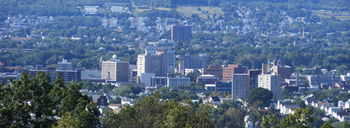
Television
- WNEP-TV 16 ABC Affiliate
- WBRE-TV 28 NBC Affiliate
- WYOU-TV 22 CBS Affiliate
- WVIA-TV 44 PBS Affiliate
- WOLF-TV 56 FOX Affiliate
- WQMY 53 MyNetworkTV Affiliate
- WSWB 38 CW Affiliate
Radio
Wilkes-Barre's radio market is ranked #69 by Arbitron's ranking system. The following box contains the list of all radio stations receivable in the area.
- WRGN-The Good News Network 88.1FM and 100.3FM
- WMGS-Magic 93
- WBHT-97BHT-Hit Radio
- WSJR-JR 93.7 Country Radio
- WBSX-97.9X Active Rock
- WGGY-Radio Country
- WILK News Radio Station
- WKRZ - 98.5 popular music
- WEZX-106.9 Rock 107 Classic Rock
Large Employers not otherwise mentioned
- GUARD Insurance Group
- Lord & Taylor Distribution Center
- Benco Dental Supply Co
|
||||||||||||||
Miscellany
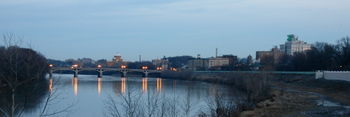
- The Collier brothers' book "My Brother Sam is Dead", is is revealed in the end Timmy and his mother move to Wilkes-Barre.
- HBO recognizes Wilkes-Barre as the birthplace of modern cable programming. In November 1972 (coincidentally the autumn that followed Hurricane Agnes), 365 subscribers of Service Electric Cable were the first to receive HBO's service.
- Wilkes-Barre was a stop on the Underground Railroad before the Civil War.
- Louis Philippe, the King of France from 1830 to 1840, stayed in Wilkes-Barre while traveling en route to the French Asylum settlement in 1797.
- Wilkes-Barre has been a popular stop for many presidential candidates: U.S. presidents Rutherford B. Hayes, Grover Cleveland, Theodore Roosevelt, Harry S. Truman, John F. Kennedy, Richard Nixon, Jimmy Carter, Ronald Reagan, Bill Clinton, George W. Bush and Barack Obama.
- Described by many today as one of America's more "historical cities", Wilkes-Barre has gained considerable bad press (although it is not a major nationally recognized location) since the Knox Mine Disaster. In the 1960 presidential campaign, it garnered attention for its high levels of poverty. In 1972, the damage done by the Agnes flood made international headlines. In the 1990s, the city became known for the poor leadership of Mayor McGroarty. In 2001, a Washington Post columnist described Wilkes-Barre as "awful" and "next-door" Scranton as "awfuler", describing the area as one of the worst metropolitan areas in the United States.[4] In 2006, the city made the front page of national newspapers when 200,000 residents were told to evacuate in the wake of flooding that was forecast to reach levels near that of '72 but fell short of predictions.
- Wilkes-Barre is thebirthplace of the Planters Peanuts Company, which was founded in 1906 by Italian immigrant Amedeo Obici and partner Mario Peruzzi.
- It is said that one of the longest home runs in history was hit in Wilkes-Barre. This statement is quoted right from the Scranton/Wilkes-Barre Yankees News page:"On October 12, 1926, Babe Ruth visited Wilkes-Barre's Artillery Park to play in an exhibition game between Hughestown and Larksville. Suiting up for Hughestown, the Yankee slugger challenged Larksville's hurler Ernie Corkran to throw him his "best stuff"—a fastball right down the heart of the plate. Corkran obliged and Ruth crushed the pitch into deep right field. When the ball cleared the fence, a good 400 feet away from home plate, it was still rising. It finally landed in Kirby Park on the far side of a high school running track. Ruth himself was so impressed by the feat that he asked that his homer be measured. Originally estimated at 650 feet, the prodigious blast is considered to be the longest home run in baseball's storied history.[5]
- The Wilkes-Barre variation (or Traxler variation, as it is more commonly known) of the Two Knights' Defense is named for the Wilkes-Barre chess club.[6]
- Bingo was popularized after a Wilkes-Barre church preacher approached the game's developer complaining that the original game was not random enough in its potential picks to limit winners. The resulting improvements, in response to that complaint, led directly to the cultural success of the game.[7]
- Author Michael Charles Rogers used Wilkes-Barre (and its surrounding communities) as the setting for his novel, Dead Angels Bleed.[8]
Notable natives and residents
- David Bohm, quantum physicist
- Benjamin Burnley, lead singer and guitarist for alternative metal band Breaking Benjamin
- Cold World, hardcore punk band
- Colleen Corby, Sixties fashion model [9]
- George Catlin, artist
- Francis A. "Mother" Dunn, football player for the Canton Bulldogs
- Jesse Fell, early experimenter with anthracite coal
- Pat Finn, game show host whose shows include PAX's Shop 'Til You Drop
- Ham Fisher, cartoonist
- Florence Foster Jenkins, unconventional operatic soprano
- George Washington Helme, businessman and founder of Helmetta, New Jersey
- Qadry Ismail, former NFL player who played wide receiver on the 2001 Super Bowl champion Baltimore Ravens
- Raghib Ismail, former NFL player and Heisman Trophy runner-up
- Candy Jones, fashion model, writer and radio talk show host [10]
- Dorothy Andrews Elston Kabis, treasurer of the United States
- James Karen, actor
- Mike Konnick, former MLB player
- Mary Jo Kopechne (1940–1969), passenger in the car driven by the late Senator Edward Kennedy at Chappaquidick.
- Harley Jane Kozak, actress and author
- Franz Kline, world-renowned Abstract Expressionist painter
- Matthew Lesko, infomercial personality
- Joseph L. Mankiewicz, Academy award winning director and producer.
- Edward B. Lewis, winner of the 1995 Nobel Prize in physiology and medicine
- Mary McDonnell, actress twice nominated for Academy Award
- Albert Mudrian, author and magazine editor
- Jozef Murgas, radio pioneer
- Amadeo Obici, founder of Planters Peanuts
- Jerry Orbach, Tony award-winning actor
- John Paluck, football player for the Washington Redskins and pro-bowler
- William Daniel Phillips, winner of the 2001 Nobel Prize in physics
- Mendy Rudolph, former NBA referee from 1953 to 1975
- Michael Schoeffling, actor who played Jake Ryan in 80s classic film Sixteen Candles
- M. Gerald Schwartzbach, California criminal defense attorney [11]
- Greg Skrepenak, former NFL player
- Jonathan Slavin, character actor
- Bob Sura, basketball player, Houston Rockets
- Louis Teicher, pianist; member of the duo Ferrante & Teicher
- Alexis Toth, (St. Alexis of Wilkes-Barre) a saint in the Russian Orthodox Church
- Ed Walsh, Hall of Fame pitcher; major league baseball's all time ERA champion
- Harry Welsh, first lieutenant in Easy Company
- Ira W. Wood, represented New Jersey's 4th congressional district from 1904 to 1913 [12]
See also
- Wilkes-Barre Township, Pennsylvania
References
- ↑ Table 7. Cumulative Estimates of Population Change for Metropolitan Statistical Areas and Rankings: April 1, 2000 to July 1, 2007, U.S. Census Bureau, 2007. Retrieved 04 September 2008.
- ↑ "American FactFinder". United States Census Bureau. http://factfinder.census.gov. Retrieved 2008-01-31.
- ↑ "US Gazetteer files: 2000 and 1990". United States Census Bureau. 2005-05-03. http://www.census.gov/geo/www/gazetteer/gazette.html. Retrieved 2008-01-31.
- ↑ Weingarten, Gene (2001-12-02). "Why Not the Worst?". Washington Post. p. W12. http://www.washingtonpost.com/ac2/wp-dyn/A31628-2001Nov28. Retrieved 2009-02-05.
- ↑ "Scranton/Wilkes-Barre Yankees". Minorleaguebaseball.com. 1926-10-12. http://www.minorleaguebaseball.com/news/article.jsp?ymd=20070702&content_id=269068&vkey=news_t531&fext=.jsp&sid=t531. Retrieved 2010-06-24.
- ↑ this article by Alex Dunne.
- ↑ History of Bingo.
- ↑ Dead Angels Bleed: A Defiant New Novel of Death Fiction.
- ↑ Kahn, S. "Modeling: Money and Madness!", Teen, December 1963.
- ↑ Flint, Peter B. "Candy Jones Dies; Ex-Model, Teacher, And Writer Was 64", The New York Times, January 19, 1990. Retrieved December 20, 2007.
- ↑ Andrew Blankstein (March 28, 2005). "Attorney Makes Mark by Taking Cases That Others Avoid". Los Angeles Times. http://pqasb.pqarchiver.com/latimes/access/813239741.html?dids=813239741:813239741&FMT=ABS&FMTS=ABS:FT&type=current&date=Mar+28,+2005&author=Andrew+Blankstein&pub=Los+Angeles+Times&desc=CALIFORNIA;+PROFILE+.
- ↑ Ira Wells Wood, Biographical Directory of the United States Congress. Retrieved September 6, 2007.
External links
- Wilkes-Barre travel guide from Wikitravel
- City of Wilkes-Barre
- Osterhout Free Library
- Wilkes-Barre Bicentennial
- "Wilkes-Barre Preservation Society". Archived from the original on 2008-01-19. http://web.archive.org/web/20080119021223/http://www.diamondcity200.org/.
- More interesting facts about Wilkes-Barre
|
|||||||||||||||||||||||
|
|||||||||||
|
|||||||||||||||||||||||
|
|||||
